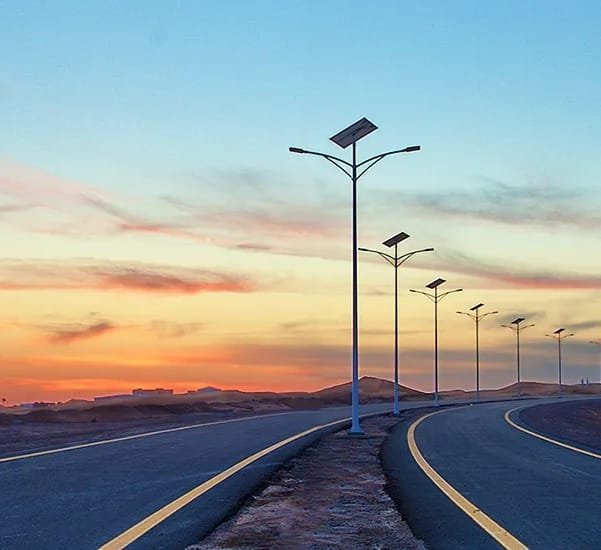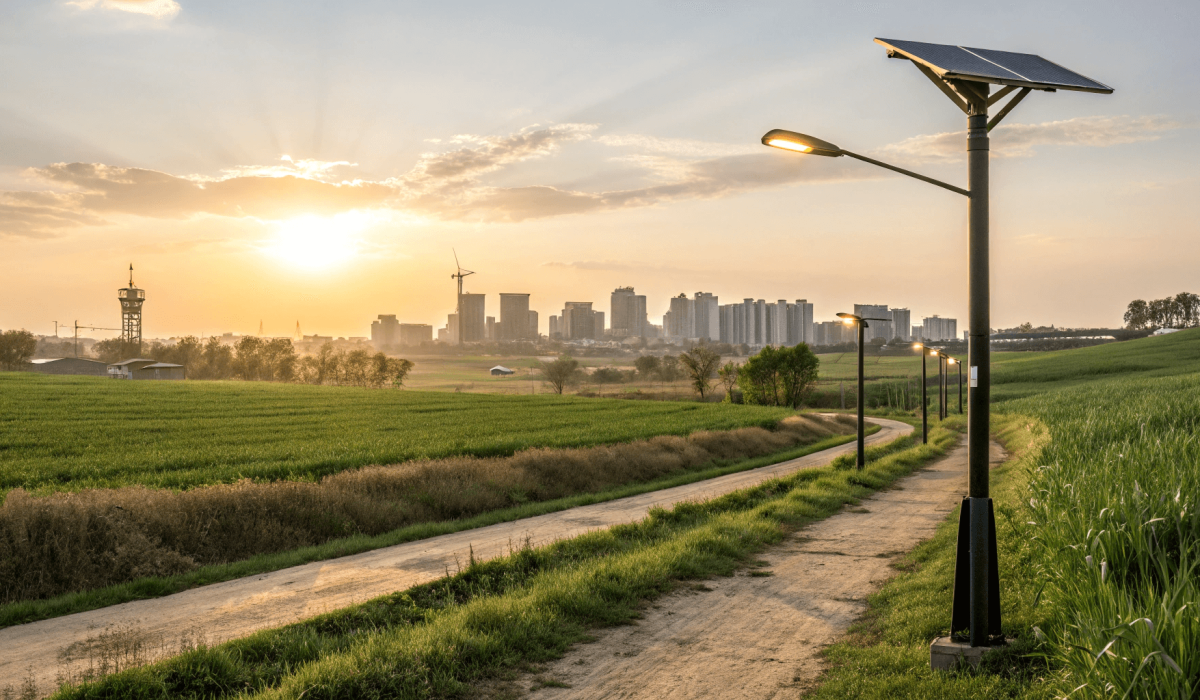Buying solar street lights should be simple. But I’ve seen too many people make the same costly mistakes—then wonder why the lights fail after just one rainy season.
In this guide, I’ll show you five common errors people make when choosing solar street lights—and what you should do instead. Avoiding these will save money, time, and headaches.
What Is a Solar Street Light and How Does It Work?
A solar street light is a self-contained outdoor lighting system that runs without being connected to the grid. It includes a solar panel, a rechargeable battery (usually lithium or GEL), a charge controller, and a high-efficiency LED light mounted on a pole. During the day, the solar panel collects sunlight and charges the battery. At night, the stored power runs the light automatically.
There are two main types: off-grid solar lights, which work fully independently, and hybrid solar lights, which have backup grid power.
Why More People Are Choosing Solar Street Lights?
Solar street lighting is now being adopted in cities, towns, factories, parks, and rural areas—especially in regions with unreliable grid power. The reasons are clear:
- Lower installation costs (no trenching or wiring)
- No monthly electricity bill
- Sustainable and eco-friendly
- Reliable during blackouts or natural disasters
And with better batteries and smarter controllers, the lights now last longer and work more consistently, even in tough weather conditions.
Different Types of Solar Street Lights?
There are three common designs. All-in-one lights are compact and easy to install, ideal for small projects. Split-type lights separate the panel, battery, and light, offering better performance for large areas or high-wattage needs. Smart solar lights come with motion sensors, remote control, or IoT integration—great for cities or parking areas that need adaptive lighting.
Each type has pros and cons. The right choice depends on your location, usage hours, lighting level, and budget.
5 Common Mistakes to Avoid When Buying Solar Street Lights?
-
Focusing Only on Price
The lowest price often comes with cheap batteries, weak frames, and unreliable controllers. It might save money upfront—but you’ll likely spend more on replacements, repairs, or total failure. A well-built system costs more but lasts 3–5 times longer. -
Thinking More LEDs = Brighter Light
Brightness comes from the system's actual lumens, not the number of chips. Some sellers advertise “1,000 LEDs” but power them with a tiny controller. What matters is how much usable light the system can deliver and maintain through the night. -
Picking Lights Based on High Wattage Alone
Higher wattage does not mean better performance. If the battery can't support that wattage for 12 hours, it will run out halfway through the night. Worse, high-wattage lights installed too low cause glare and uneven lighting. Always match light power to the site’s real requirements. -
Ignoring Battery Capacity and Specs
The battery is the heart of the system. You should always check both voltage and capacity (Ah). A good setup has a battery big enough to run the light for 2–3 cloudy days. Many low-cost models cut corners on battery size, which leads to dim lights or early shutoff.
| Battery Type | Lifespan | Charging Speed | Cost | Maintenance |
|---|---|---|---|---|
| GEL | 2–3 years | Medium | Low | Medium |
| LiFePO₄ | 5–8 years | Fast | Higher | Low |
- Installing Panels Without Proper Orientation
I’ve visited sites where panels were installed facing west or covered by tree shade—resulting in undercharged batteries and lights that shut off by midnight. The panel should face true south (in the Northern Hemisphere), be tilted at an angle close to the site’s latitude, and have full sunlight from 9 a.m. to 4 p.m.
What to Consider Before You Choose a Solar Light?
Before buying, it helps to prepare a checklist. This avoids mismatches between product specs and site requirements.

| Factor | What to Check |
|---|---|
| Light Coverage Area | Total space and pole height |
| Sunlight Availability | At least 4–5 sun hours daily (no shade) |
| Battery Backup Hours | Can it last 2–3 cloudy days? |
| Controller Settings | Dusk-to-dawn or custom timer |
| IP & IK Rating | Waterproof (IP65+), Anti-impact (IK08+) |
| Warranty & Certification | Minimum 3 years, CE/ROHS/ISO or local equivalent |
Get these wrong, and even the best products won’t perform well.
The Future of Solar Street Lighting?
We’re seeing more projects now using smart solar poles, with:
- Motion sensors that dim the light when no one’s around
- Remote diagnostics and performance tracking
- Cameras or Wi-Fi routers built into the pole
- Hybrid solar + grid backup with smart load sharing
For municipalities, this means less energy, more control, and better safety. For businesses, it means reliable light without a growing electric bill.
Conclusion
Buying the right solar street light is not just about finding a product. It’s about matching that product to your site, your climate, and your goals. Avoid the five mistakes we’ve discussed—cheap materials, wrong specs, poor positioning, and short-term thinking.
Solar lights are a long-term investment. When done right, they can last 8–10 years, run with zero grid power, and cut lighting costs to near zero.
FAQ
Q1: What’s the biggest mistake to avoid when buying solar street lights?
Choosing based on price or wattage alone. Always check battery, controller, and solar panel specs.
Q2: Can I install solar street lights myself?
For small projects, yes. Just follow the manual. For larger ones, or anything over 6 meters tall, use professional help.
Q3: How long do solar street lights last?
With good parts and maintenance, the full system can last 8–10 years. The battery may need replacement after 3–5 years.


